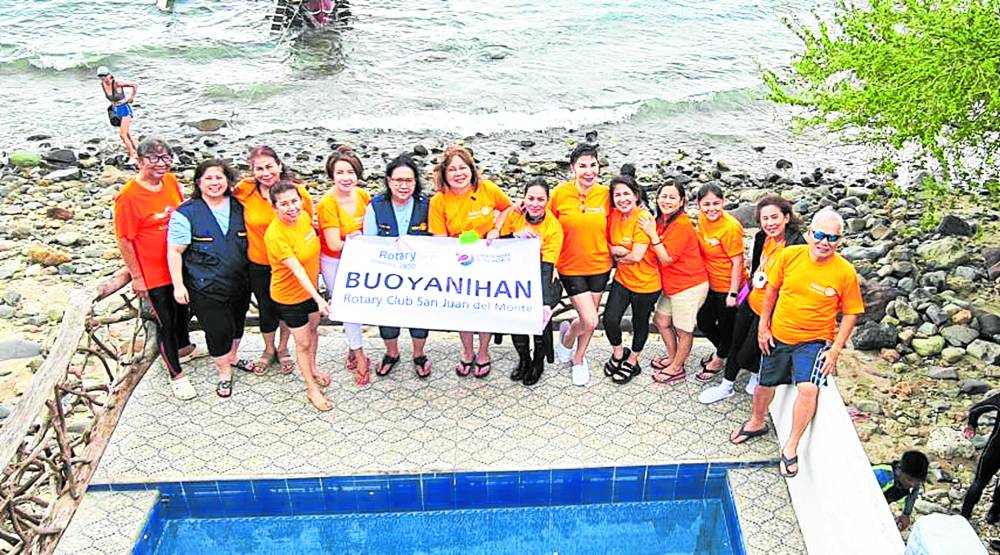Off the coast of Mabini, Batangas, diver Shenna Jaye Quitoriano took her usual plunge into the waters of Balayan Bay. Expecting resplendent marine life and its hidden wonders, she was shocked at the zombie coral colonies and their graying skeletons, covered with algae. Even more disturbing was the extensive breakage of coral reefs, mostly wrought by the indiscriminate anchoring of boats.
As a member of the Rotary Club of San Juan del Monte (RCSJDM), Quitoriano raised this concern to her District 3800. Although these coral reefs overlay a small section of the water floor, they provide enormous benefits to people, particularly food and livelihood.
Balayan Bay is part of the Verde Passage, the strait that links Luzon and Mindoro to the South China Sea. The passage is known as the “Center of the Center of Marine Shorefish Biodiversity.”
Balayan Bay had abundant tropical fish stock until numbers dramatically dropped in the early 21st century due to overfishing. And, now the yields could further decline, aggravated by coral reef damage, no thanks to human carelessness. Coral reefs are not only representations of marine biodiversity but also nurseries for fish.
READ: A socially distanced scuba diving weekend in Batangas
Terrie Mariposa, RCSJDM president, said that when Quitariano reported her sighting, the district immediately took it as the flagship project, since the environment is one of the Rotary Club’s advocacies.
Mariposa said members conducted a community assessment by asking the locals about their challenges. Fisherfolk with small boats needed to anchor so that they wouldn’t be capsized by the strong winds.
Threat
Mario Elumba, a professional diver and member of the Philippine Coast Guard Auxilliary (PCGA), noted that during the weekends, the barangay of Anilao is host to about a thousand divers. With an average of 150 boats a day and many divers doing two to three dives, that would reach as much as 450 anchor drops to secure their boats.
For every anchor drop, whether the boat was used for recreational diving or for fishing, the movement of the boat chain or the weight of the anchor could threaten the coral reef. He noted that while some government agencies and the local government have set up improvised buoys, these were insufficient to meet the demand.
Elumba has been helping other Rotary districts put up artificial reefs to support reef restoration and promote aquaculture. He said RCSJDM’s “save the reef” campaign is unique to them.

“Buoyanihan” is a portmanteau of the “buoys” that holds vessels instead of anchoring them, and “bayanihan” for cooperation and volunteerism. Mariposa, past president Bubot Sarmiento and key members scoured marine stores in Manila to source maritime-standard mooring buoys. They likewise provided funds for the board and lodging for the volunteer divers who installed the buoys.
Coral breakage
RCSJDM enlisted the PCGA, a volunteer nongovernmental organization, and the National Marine and Environmental Protection Support Group to install floating buoys in Batangas.
Elumba added that during the first installation in October last year, 40 members of the Philippine Coast Guard assisted them with the coastal clean-up. In mid-February this year, more RCSJDM members came to support the program. At this writing, 12 maritime-standard mooring buoys have been fixed in certain sites in Mabini. Boaters can fasten their vessels to the buoys instead of sinking an anchor to secure their vessels.
Asked about the impact of the Buoyanihan project, Elumba replied, “Five minutes after we installed the buoys last October, a boat was tied to one of them. That prevented an anchor drop and saved a coral reef.”
In the larger context, the RCSJDM aims to make the public aware of the importance of coral reefs and the man-made threats to our marine biodiversity, such as coral breakage and the repercussions.
READ: Saving 25 coral reefs for our 25 years of marriage
The fish from these corals are an important food source to legions of people. The limestone branches form barriers that protect the coast from storms and help to prevent flooding. The beauty of our marine biodiversity brings in millions of tourism pesos. Collectively, the coral reefs support tourism-related services and goods.
In a statement, the RCSJDM expressed, “Through this collaborative effort, the waters of Mabini, Batangas, will be safer for boaters, divers, marine life and preserve the underwater environment.” —Contributed INQ